 Home & Garden
Home & Garden
 Tomatos
Tomatos
Don's Home
 Home & Garden
Home & Garden
 Tomatos
Tomatos
|
|
Contents: Types | Support Systems | Pruning
Types:
Hybrid vs heirloom:
Varieties of Tomato Plants, Buy Tomato Seeds, Determinate, Indeterminate Tomatoes | GardenersNet.com The Difference Between Heirloom and Hybrid Tomatoes | MyHomegrownTomatoes.com Support Systems The main purpose of supporting tomato vines is to keep the plants off the ground where tomatos may rot. There are several basic systems, caging, staking, stringing and trellises. See Tomato Staking Techniques Evaluation | Master Gardeners of Santa Clara County
| ||
|
Caged - Caged tomato vines produce more fruit of a smaller size. Hard to see/collect fruit inside cage due to foliage if plant is not pruned. |
Staked - You can grow almost twice as many staked tomatoes in a given area - Staked and tied plants produce less fruit which mature earlier yet are larger - Better disease control because of better air circulation. | |
Cages | ||
Stake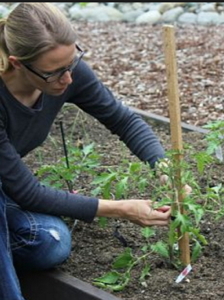
|
Trellis Multi Stake 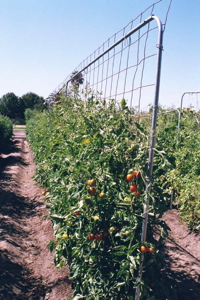

| |
|
Vertical String  Cut lengths of natural fiber twine (heavy gauge) and tie a Bowline knot at bottom of main young tomato stems when plants begin to sprawl. Twirl the twine around the stems to top of plants in approximately 3 cycles. Tie the excess twine to the horizontal conduit using a clove hitch with a slipknot so it can easily be untied in order to gather more of the plant stems as they grow.
Cut lengths of natural fiber twine (heavy gauge) and tie a Bowline knot at bottom of main young tomato stems when plants begin to sprawl. Twirl the twine around the stems to top of plants in approximately 3 cycles. Tie the excess twine to the horizontal conduit using a clove hitch with a slipknot so it can easily be untied in order to gather more of the plant stems as they grow.
Staking 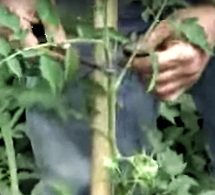 Prune off suckers so you have one main branch.
Prune off suckers so you have one main branch.Tie the branch to the steak adding ties as it grows. Use pieces of cloth rather than twine which might abrade the stem. Loop the cloth around the stem so it doesn't slide up and down. Staking at U. Main Pruning 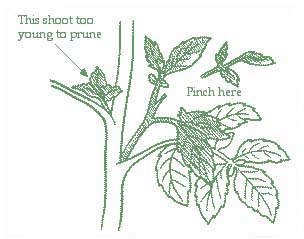 Pruning is not always necessary. However, when pruning your tomatoes, remember these main points:
Pruning is not always necessary. However, when pruning your tomatoes, remember these main points:
Plants with two or more stems produce more tomatoes with better foliage protection from the sun than plants with one stem. However, tomatoes pruned to one leader will bear earlier but with less yield overall. Choose the stems you want to keep and pinch out the others as they develop. A dense leaf canopy may reduce the incidence of black mold and cracking but may increase the incidence of other fruit molds such as gray mold. Severe pruning to one stem will reduce your total crop greatly and also is likely to increase the incidence of some diseases or disorders.
To properly prune a determinate tomato, pinch all suckers from the ground level to the first flower cluster . A sucker is a small stem that is growing between the main trunk and stem of a tomato.
To properly prune an indeterminate tomato, prune all suckers from the ground level up to the second flower cluster. (diagram to the right).
Supplies Grow-Box 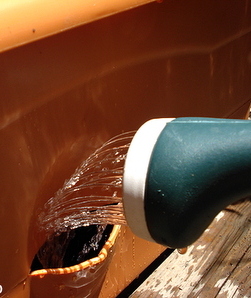
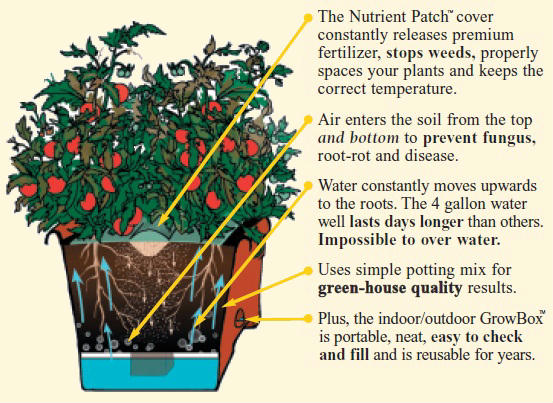
Gro-Box | The Garden Patch Watering You want to keep the soil in your pots consistently moist - not wet, but damp. Too much water and the plants drown, too little and you get blossom end rot. Before you water, check if your soil is already moist. To do this put your finger into the soil about an inch or two (a good way to do this is going to your second knuckle). Add water if the soil feels dry to the touch at your fingertip, Links: How to Stake and Cage Tomatoes Video - Home Gardening Tips and Advice | Burpee Tomato Cages, Stakes or Trellises: Which is best for Supporting Heirloom Tomatoes? Pruning and Staking Tomatoes - Perfect Techniques - YouTube Garden Tips and Tricks - Staking Tomato Plants
| ||